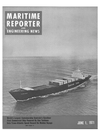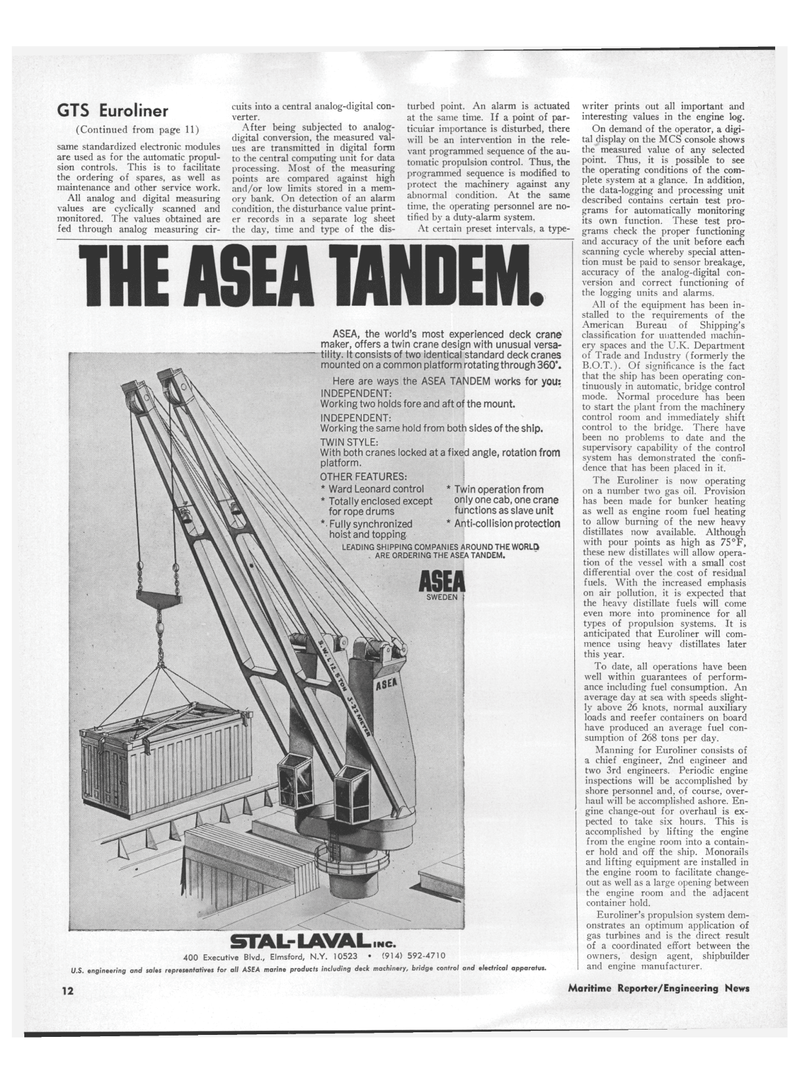
Page 10: of Maritime Reporter Magazine (June 1971)
Read this page in Pdf, Flash or Html5 edition of June 1971 Maritime Reporter Magazine
GTS Euroliner (Continued from page 11) same standardized electronic modules are used as for the automatic propul- sion controls. This is to facilitate the ordering of spares, as well as maintenance and other service work.
All analog and digital measuring values are cyclically scanned and monitored. The values obtained are fed through analog measuring cir- cuits into a central analog-digital con- verter.
After being subjected to analog- digital conversion, the measured val- ues are transmitted in digital form to the central computing unit for data processing. Most of the measuring points are compared against high and/or low limits stored in a mem- ory bank. On detection of an alarm condition, the disturbance value print- er records in a separate log sheet the day, time and type of the dis- turbed point. An alarm is actuated at the same time. If a point of par- ticular importance is disturbed, there will be an intervention in the rele- vant programmed sequence of the au- tomatic propulsion control. Thus, the programmed sequence is modified to protect the machinery against any abnormal condition. At the same time, the operating personnel are no- tified by a duty-alarm system.
At certain preset intervals, a type- writer prints out all important and interesting values in the engine log.
On demand of the operator, a digi- tal display on the MCS console shows the measured value of any selected point. Thus, it is possible to see the operating conditions of the com- plete system at a glance. In addition, the data-logging and processing unit described contains certain test pro- grams for automatically monitoring its own function. These test pro- grams check the proper functioning and accuracy of the unit before each scanning cycle whereby special atten- tion must be paid to sensor breakage, accuracy of the analog-digital con- version and correct functioning of the logging units and alarms.
All of the equipment has been in- stalled to the requirements of the
American Bureau of Shipping's classification for unattended machin- ery spaces and the U.K. Department of Trade and Industry (formerly the
B.O.T.). Of significance is the fact that the ship has been operating con- tinuously in automatic, bridge control mode. Normal procedure has been to start the plant from the machinery control room and immediately shift control to the bridge. There have been no problems to date and the supervisory capability of the control system has demonstrated the confi- dence that has been placed in it.
The Euroliner is now operating on a number two gas oil. Provision has been made for bunker heating as well as engine room fuel heating to allow burning of the new heavy distillates now available. Although with pour points as high as 75°F, these new distillates will allow opera- tion of the vessel with a small cost differential over the cost of residual fuels. With the increased emphasis on air pollution, it is expected that the heavy distillate fuels will come even more into prominence for all types of propulsion systems. It is anticipated that Euroliner will com- mence using heavy distillates later this year.
To date, all operations have been well within guarantees of perform- ance including fuel consumption. An average day at sea with speeds slight- ly above 26 knots, normal auxiliary loads and reefer containers on board have produced an average fuel con- sumption of 268 tons per day.
Manning for Euroliner consists of a chief engineer, 2nd engineer and two 3rd engineers. Periodic engine inspections will be accomplished by shore personnel and, of course, over- haul will be accomplished ashore. En- gine change-out for overhaul is ex- pected to take six hours. This is accomplished by lifting the engine from the engine room into a contain- er hold and off the ship. Monorails and lifting equipment are installed in the engine room to facilitate change- out as well as a large opening between the engine room and the adjacent container hold.
Euroliner's propulsion system dem- onstrates an optimum application of gas turbines and is the direct result of a coordinated effort between the owners, design agent, shipbuilder and engine manufacturer.
THE ASEA mm
ASEA, the world's most experienced deck crane maker, offers a twin crane design with unusual versa- tility. It consists of two identical standard deck cranes mounted on a common platform rotatingthrough 360'.
Here are ways the ASEA TANDEM works for you:
INDEPENDENT:
Working two holds fore and aft of the mount.
INDEPENDENT:
Working the same hold from both sides of the ship.
TWIN STYLE:
With both cranes locked at a fixed angle, rotation from platform. OTHER FEATURES: * Ward Leonard control * Totally enclosed except for rope drums *• Fully synchronized hoist and topping
LEADING SHIPPING COMPANIES AROUND THE WORLD . ARE ORDERING THE ASEA TANDEM.
Twin operation from only one cab, one crane functions as slave unit
Anti-collision protection
INC. 400 Executive Blvd., Elmsford, N.Y. 10523 • (914) 592-4710
U.S. engineering and sales representatives for all ASEA marine products including deck machinery, bridge control and electrical apparatus. 12 Maritime Reporter/Engineering News

 9
9

 11
11
